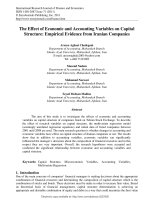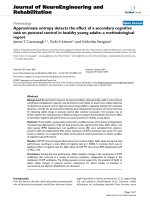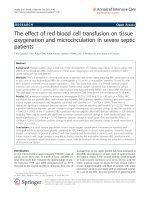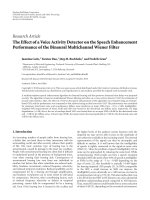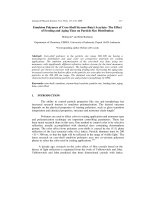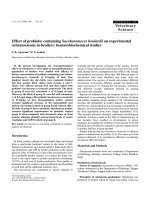The effect of CDK1 mediated GOLGI vesiculation on mitotic progression in mammalian cells
Bạn đang xem bản rút gọn của tài liệu. Xem và tải ngay bản đầy đủ của tài liệu tại đây (1.18 MB, 59 trang )
THE EFFECT OF CDK1 MEDIATED GOLGI
VESICULATION ON MITOTIC PROGRESSION IN
MAMMALIAN CELLS
SRIRAMKUMAR SUNDARAMOORTHY
(B.Tech., Anna University)
A THESIS SUBMITTED
FOR THE DEGREE OF MASTER OF SCIENCE
DEPARTMENT OF BIOLOGICAL SCIENCES
NATIONAL UNIVERSITY OF SINGAPORE
2009
i
ACKNOWLEDGEMENTS
At the outset, I would like to thank my supervisors Dr. Maki Murata-Hori at
the Temasek Life Sciences Laboratory and Dr. Cynthia He at the
Department of Biological Sciences at the National University of Singapore
for providing me with an opportunity to work under them. It is entirely due
to their motivation and guidance that I have able to graduate from being
just a learner to a researcher.
Entering as a rookie in biomedical
research, the past two years have not only given me exposure to and
experience in various techniques in cellular biology but it has given me a
glimpse of the inside world of scientists and instilled in me a strong sense
of belonging. Just as importantly, I have been able to develop an ability to
think, plan and work independently on answering a specific scientific
question.
I am indebted to members of the Mammalian Cell Biology (MCB) group at
the Temasek Life Science laboratory for helping me in all ways possible.
A very big thank you to Lana, Shyan and Xiao Dong for having had to
endure my umpteen questions when I started doing research in the lab.
Special thanks to Vinayaka for being a very argumentative sounding
board for many of my ideas both scientific and otherwise. I am also
grateful to Tzuy for her invaluable counselling sessions. Also thanks to
Shaz for being pleasant enough to help me with my requests. I would like
to thank them all for helping me troubleshoot during these two years of
study in NUS. I am also grateful to the members of the Cynthia lab for
ii
their support during my initial months in Singapore and for the many hours
of productive and stimulating discussions later.
I also extend my thanks to my thesis committee members, Dr. Gregory
Jedd and Dr. Frederic Bard for their invaluable advice for this thesis.
I would like to thank my friends and relatives in Singapore and in other
parts of the world for having supported and guided me through the past 2
years. Special mention of thanks to Madhu, Nisha, Arvind, Arjun and
Diwa. I am also thankful to my parents for supporting me not only through
my MSc but also throughout my life.
Finally I would like to thank Dr. Richard Dawkins, until recently the
Charles Simonyi professor for the Public Understanding of Science at the
Oxford University for having fostered in me a sense of curiosity towards
the natural world and for having instilled in me the tenacity to question
dogmas and faiths.
iii
Table of Contents
Acknowledgements
i
Table of Contents
iii
List of Figures
vi
List of Tables
viii
List of Abbreviations
ix
Summary
xi
Chapter 1: Introduction
1
1.1 Cell division; the basis for cell multiplication and life on
earth
1
1.2 The Golgi apparatus
2
1.2.1 Golgi structure and inheritance
2
1.2.2 Golgi ribbon undergoes severing during G2 phase
4
1.2.3 The mechanism of Golgi vesiculation
7
1.2.3.1 The reason for Golgi vesiculation
7
1.2.3.2 The role of GM130 in COPI- dependent Golgi
vesiculation
8
Chapter 2: Materials and methods
12
2.1 Cell line
12
2.2 Reagents
2.2.1 Solutions
12
iv
2.2.2 Drugs
12
2.2.3 Antibodies
12
2.3 Cell culture
2.3.1 Culture conditions
2.4 Molecular biology
14
14
15
2.4.1 E.coli strain used and plasmid amplification strategy
15
2.4.2 Plasmid construction
15
2.4.3 ShRNA
16
2.5 Plasmid transfection
16
2.6 Microscopy
17
2.6.1 Sample preparation for live imaging
17
2.6.2 Sample preparation for immunofluorescence
17
2.6.3 Image acquisition
18
2.6.4 Image analysis
18
2.6.4.1 Quantification of fluorescence intensity
Chapter 3: Results
18
20
3.1 The mammalian Golgi apparatus undergoes
dynamic changes during mitosis
20
v
3.2 Purvalanol A treatment affects Golgi vesiculation
and mitotic progression
3.3 Purvalanol A treatment abolished GM130 phosphorylation
22
24
3.4 Over expression of GM130 does not affect Golgi dynamics
or mitosis
27
3.5 ShRNA against GM130 successfully depleted GM130
29
3.6 Depletion of GM130 does not affect Mitotic progression
30
3.7 GM130 over expression does not affect mitotic
progression or Golgi vesiculation
31
Chapter 4: Discussion
34
4.1 Golgi dynamics during mitosis is dependent on cdk 1
34
4.2 Perturbing GM130 does not modulate Golgi vesiculation
or mitosis
36
Chapter 5: Conclusion
43
Chapter 6: References
44
vi
List of figures
Figure 1.1
Figure 1.2
Figure 3.1
Figure 3.2
Figure 3.3
Figure 3.4
Figure 3.5
Figure 3.6
Figure 3.7
Figure 4.1
The Golgi undergoes dramatic morphological changes
during mitosis
COP 1 vesicle tethering under interphase and mitotic
conditions
Golgi undergoes dynamic changes during mitosis
Golgi vesiculation and mitotic progression were affected
in purvalanol A treated cells
Phosphorylation of GM130 S25 was abolished in
purvalanol-A treated cells
Golgi dynamics was unaffected by GM130 over
expression
ShRNA against rat GM130 depleted endogenous
GM130 efficiently
Depletion of GM130 did not affect mitotic progression
Over expression of S25A GM130-tomato in cells
depleted of GM130 does not affect Golgi vesiculation
Schematic representation of the hypothesised regulation
of mitotic Golgi vesiculation by GM130
4
9
21
23
25
28
30
31
33
39
vii
List of tables
Table 1.1
Table 2.1A
Table 2.1B
List of kinases involved in regulating Golgi
structure and function
Primary antibodies used in this study
Secondary antibodies used in this study
6
13
13
viii
List of abbreviations
BARS
Brefeldin A (BFA) Adenosine Diphosphate–Ribosylated
Substrate
CDK
Cyclin Dependent Kinase
CGN
Cis Golgi Network
COP1
Coat Promoter 1
DNA
Deoxyribonucleic acid
EDTA
Ethylene Di amine Tetra acetic Acid
ERK
Extracellular signal Regulated Kinase
ER
Endoplasmic reticulum
F12K
Kaighn’s modified F12
GalT
Galactosyltransferase
GFP
Green fluorescent Protein
GRASP65
Golgi Reassembly Stacking Protein
HELA
Henrietta Lacks
HBBS
Hank’s balanced salt solution
KDa
Kilo Dalton
LB
Luria Bertani
MEK 1
Mitogen Activated Kinase 1
MGC
Mitotic Golgi Clusters
MTOC
Microtubule Organizing Centre
NC
Negative Control
NRK
Normal Rat Kidney
PBS
Phosphate Buffered Saline
PCR
Polymerase chain reaction
RNA
Ribo Nucleic Acid
ShRNA
Short Hairpin RNA
STE
Sodium Tris EDTA
TGN
Trans Golgi Network
ix
Summary
The mammalian Golgi consists of hundreds of Golgi stacks interlinked to
form a single ribbon structure in the peri‐nuclear area. During mitosis,
the Golgi undergoes two sequential fragmentation steps to break from
ribbon to individual stacks, then from stacks to vesicles and tubules. The
first fragmentation step is mediated by phosphorylation of the Golgi
matrix protein GRASP65 and it has been shown to be essential for G2‐M
transition. To understand if the second, vesiculating step might be
involved in mitotic progression, we looked at GM130, a Golgi matrix
protein mitotically phosphorylated by Cdk1 and thought to be essential
for the mitotic Golgi vesiculation. When NRK cells were treated with the
Cdk1 inhibitor purvalanol A, Golgi vesiculation was blocked and
organisation of the mitotic spindle was affected and mitotic progression
was delayed. Over expression of a GFP fusion to a GM130
phosphorylation mutant (S25A) had no apparent effect on Golgi
vesiculation and mitotic progression. Also, depletion of GM130 showed
no effect on cell cycle progression. Further down, over expression of the
mutant GM130 (S25A) in the background of the depletion showed no
apparent defects in Golgi vesiculation or mitotic progression. Our work
suggests while Cdk1 based phosphorylation is essential for mitotic Golgi
vesiculation and mitotic progression, cells might have redundant
downstream pathways that ensure that Golgi vesiculation proceeds in
spite of inactivation of any single component.
x
1. Introduction
1.1 Cell division; the basis for cell multiplication and life on earth
All living organisms have the same basic functional unit that makes them
up; the cell. Nearly 150 years after Rudolph Virchow famously proposed
that all cells arise from pre existing cells(Tan and Brown 2006), we have
made great progress in furthering his theory. However, we are still in the
dark about the finer details of the mechanism that allows a cell to
generate daughter cells. The cell reproduces by firstly duplicating its
contents, segregating them and then redrawing its boundaries. In the
process, it passes though a carefully regulated cycle of events called the
cell cycle.
The eukaryotic cell cycle has been best studied in yeasts and mammalian
cells. It consists of two phases, the interphase and the mitotic phase (Mphase). The interphase in turn is made up of three phases; the first gap
phase (G1-phase), synthesis phase (S-phase), and second gap phase
(G2-phase). The interphase, seemingly a period of rest for the cells is
actually a period of intense activity wherein the cell readies itself for
division by synthesizing proteins required for growth, duplicating its
genetic material and other organelles such as the centrosomes, the Golgi
among others. The mitotic phase of the cell cycle is visually much more
dynamic with the cell undergoing rapid changes in morphology. Through a
set of well orchestrated processes, the cell segregates its chromosomes
to opposite ends with the physical force required for the above essential
process being provided by one of the cytoskeletal components of the cell;
the microtubules. The other organelles in the cell such as the centrosome,
1
the ER, the Golgi among others would now have segregated through
distinct mechanisms. Following this, the cell undergoes a series of
dramatic changes in its morphology that ultimately result in the division of
the cell into two. The story ends differently depending on the cell type
(Balasubramanian, Bi et al. 2004) but in essence, a barrier is brought in
between the two nascent cells, and cell division is complete.
1.2 The Golgi Apparatus
1.2.1 Golgi structure and inheritance
The Golgi apparatus is one of the most fascinating organelles in the
eukaryotic cell. Though first identified in 1898 by the Italian physician
Camillo Golgi, many of its functions remain among the great mysteries of
the cell. In most eukaryotic cells, the Golgi exists as a network of tubules
and vesicles that are arranged into stacks of flattened cisternae. Newly
synthesized proteins from the ER are received at the cis Golgi network
(CGN), modified posttranslationally as they traverse the Golgi stack to
reach the trans Golgi network (TGN), where they are sorted for delivery to
their ultimate target (Mellman and Simons 1992)
In the plant cell and also in lower animal cells, the Golgi exist as individual
stacks that are dispersed throughout the cytoplasm. In mammalian cells
however, the Golgi apparatus often displays a juxtanuclear or
pericentriolar localization wherein the individual stacks of the Golgi are
interconnected to yield a Golgi ribbon. It has previously been shown that
the presence of the Golgi at the pericentriolar area is dependent on the
microtubules and is mediated by the action of the Rho GTPases (Nobes
2
and Hall 1999). Perturbation of the microtubules using either a
depolymerising agent (nocodazole) or a stabilizing agent (taxol) has
affected Golgi structure and localization (Sandoval, Bonifacino et al. 1984;
Turner and Tartakoff 1989; Corthesy-Theulaz, Pauloin et al. 1992; Cole,
Sciaky et al. 1996; Thyberg and Moskalewski 1999). The pericentriolar
localization of the Golgi apparatus in mammalian cells has led scientists to
speculate about the possible link between the Golgi and the centrosomes,
the Microtubule Organizing Centre of the cell (MTOC). The affinity of the
Golgi apparatus for microtubules can be attributed to the fact that the
microtubules tend to associate with the MTOC in a minus end directed
manner. The localization of the Golgi apparatus at the crucial position
could therefore be interpreted as a controlling position for monitoring and
possibly directing a number of cellular events.
The mechanism that ensures the inheritance of the Golgi to both the
daughter cells appears to be cell type-dependent, and perhaps reflects
functional requirement of Golgi during mitosis. In plants and many singlecelled organism, the Golgi is inherited as intact, individual stacks into the
daughter cells (Nebenfuhr, Frohlick et al. 2000). However, in mammalian
cells where protein secretion ceases during mitosis, the Golgi undergoes
sequential fragmentations from ribbons to dispersed stacks in G2, and
from stacks to tubules and vesicles later in metaphase. Such extensive
fragmentation steps are believed to ensure Golgi partition to both the
daughter cells in a precise manner (Lucocq, Pryde et al. 1987; Lucocq
and Warren 1987; Lucocq, Berger et al. 1989) .
3
Figure 1.1. The Golgi undergoes dramatic morphological changes
during mitosis. During prophase, the tubular connections between the
individual Golgi stacks are lost and the Golgi ribbon is broken down into
individual stacks that remain close to the nucleus. Between prophase and
metaphase, the Golgi undergoes further fragmentation whereby the
individual cisternae are converted into small ~50–70 nm vesicles, and
larger vesicular and tubular elements. These mitotic Golgi fragments
either exist as discrete units or they might fuse with the endoplasmic
reticulum (ER). During telophase, the Golgi fragments fuse with each
other to initiate the reformation of new Golgi stacks that ultimately connect
to form a Golgi ribbon in each daughter cell. Figure reproduced from:
(Lowe and Barr 2007)
1.2.2 Golgi ribbon undergoes severing during G2 phase
It was shown that in mammalian cells, the initial fragmentation event
converts the intact Golgi ribbon into isolated Golgi stacks or group of
stacks that while fragmented, remain clustered around the nucleus
(Colanzi, Carcedo et al. 2007; Feinstein and Linstedt 2007). When this
fragementationfragmentation step was blocked, by inhibiting the fissioninducing protein BARS or the kinase MEK 1 (Colanzi, Carcedo et al. 2007;
Feinstein and Linstedt 2007), the cells were arrested in G2 phase.
Supporting this, it was shown that the fragmentation of the Golgi
4
apparatus was essential for G2/M transition and entry into mitosis
(Sutterlin, Hsu et al. 2002).
By targeting the Golgi matrix protein
GRASP65 using specific inhibitory peptides and antibodies, they showed
that blocking the Golgi fragmentation process at G2 prevented cells from
entering mitosis. However, Itit remains unknown why this initial Golgi
fragmentation is essential for mitotic progression. It is possible that the
fragmentation process is designed to ensure that both the daughter cells
inherit the organelle. It is also speculated that given the proximity between
the Golgi and the centrosome, Golgi breakdown might be required for the
correct maturation and separation of the centrosomes as failure in this
fragmentation might physically prevent the MTOC reorganization during
mitosis thereby leading to mitotic failure (Colanzi and Corda 2007)
The molecular mechanism that is behind the first Golgi fragmentation
event has been extensively studied. The fission inducing protein BARS
was shown to be necessary for the process although BARS on its own is
insufficient to induce fragmentation. Subsequently it was shown that
another Golgi matrix protein GRASP65 might also be involved. GRASP 65
is a coiled coil protein that forms homodimers and it has been thought that
GRASP65 dimers located on adjacent Golgi stacks could help to link them
together to form the ribbon structure(Preisinger, Körner et al. 2005;
Wang, Satoh et al. 2005). GRASP65 carries out a number of different
functions and each of them seem to be mediated by specific
phosphorylation of specific sites.
It has been shown that GRASP65 phosphorylation at S277 is essential for
G2/M progression (Yoshimura, Yoshioka et al. 2005). In addition, it was
5
shown that the kinases MEK 1 and Plk1 might also be involved in the G2
Golgi fragmentation.
Table 1.1. List of kinases involved in regulating Golgi structure and
function. Table modified from: (Lowe and Barr 2007)
Kinases
Interaction
partners
Substrates
Proposed function of substrate
CDK1
Cyclin B
GM130
Golgi membrane and vesicle tethering
GRASP65
Membrane tethering and cisternal stacking
RAB1
Golgi membrane and vesicle tethering
p47
Membrane fusion
NIR2
Phospholipid transfer
GRASP65
GRASP65
Membrane tethering and cisternal stacking
RAB1
RAB1
Golgi membrane and vesicle tethering
Giantin
MEK1
Unknown
Not applicable
PLK1
PLK3
ERK2
MEK1
PLK3
Unknown
Not applicable
ERK1/2
PLK3
GRASP55
Cisternal stacking
ERK1c
Unknown
Unknown
Not applicable
Unknown
Unknown
Golgin-84
Golgi-membrane and vesicle tethering
The effector of MEK1 on the Golgi , ERK1c was discovered and it was
demonstrated that depletion of ERK 1c reduces Golgi fragmentation
(Shaul and Seger 2006). The target for ERK1c is speculated to be
GRASP55 as it was shown to be phosphorylated by ERK1/2 at T222 or
T225 and failure to do so delayed mitosis (Feinstein and Linstedt 2007).
Though the multiple kinases and pathways detailed above might function
together to mediate G2 specific Golgi fragmentation, their precise
regulation and function remain to be identified.
6
1.2.3 The mechanism of Golgi vesiculation
1.2.3.1 The reason for Golgi vesiculation
The reason as to why the Golgi has to undergo further fragmentation is
not clear. Accurate Golgi inheritance is possible with the individual stacks
generated
by
the
initial
fragmentation
process
and
has
been
demonstrated to be the case in many organisms such as plants. The
second fragmentation event might be essential to ensure a more accurate
inheritance or it might also have a role in regulating mitosis by releasing
factors that are sequestered in the Golgi during interphase. It is also
possible that the Golgi vesiculation might have effects on influencing the
rapid changes in the cytoskeleton that occurs during mitosis.
The second fragmentation step of the Golgi, however, has been the
source of a considerable debate in the community (Shima, Haldar et al.
1997; Shima, Cabrera-Poch et al. 1998). At the onset of mitosis, the
isolated Golgi stacks undergo further fragmentation or vesiculation to
produce a dispersed array of tubulovesicular clusters also known as the
Mitotic Golgi Clusters (MGC) (Lucocq and Warren 1987; Lucocq, Berger
et al. 1989; Warren, Levine et al. 1995; Shima, Haldar et al. 1997). The
MGCs contains most of the Golgi resident enzymes except p115 (Lowe,
Gonatas et al. 2000). The changes in the Golgi morphology are
concomitant with an elevation in Cdk 1 levels. When the cell reaches
prometaphase, the MGCs relocate and now surround the newly formed
mitotic spindle (Shima et al. 1998, Whitehead & Rattner 1998, Jokitalo et
al. 2001). The MGCs undergo still further separation just before
7
metaphase. Part of the MGC remains associated with the spindle while
the other part is distributed to the cell cortex presumably by the mitotic
spindle (Shima, Cabrera-Poch et al. 1998)
The molecular mechanism behind the mitotic Golgi vesiculation has been
studied. It is known that the mitotic disassembly of Golgi stacks proceeds
via two distinct, concurrent fragmentation pathways. The first pathway
also known as the COPI-dependent pathway proceeds because COPI
vesicles continue to bud from the Golgi stack but due to restrictions in
mitotic transport, they are unable to tether and fuse with their target
membrane (Misteli &Warren 1994, Nakamura et al. 1997). This pathway is
thought to contribute to about 65% of the mitotic Golgi vesiculation (Misteli
and Warren 1994; Misteli and Warren 1995; Sönnichsen, Watson et al.
1996). The second pathway which is also known as the COPIindependent pathway converts the flattened cisternal cores into a
heterogeneous
array of
tubulovesicular
elements via
unknown
mechanisms (Misteli and Warren 1995).
1.2.3.2 The role of GM130 in COPI- dependent Golgi vesiculation
A molecular explanation for the COPI dependent mitotic Golgi vesiculation
has been proposed. p115 is a homodimeric vesicle-tethering protein that
is required for intra-Golgi (Waters, Clary et al. 1992; Seemann, Jokitalo et
al. 2000) and ER-Golgi transport(Allan, Moyer et al. 2000; Moyer, Allan et
al. 2001). p115 brings the Golgi membrane and the vesicle membrane
together in interphase by binding to two Golgins, GM130 and Giantin
through its two arms.
8
Figure 1.2. COPI vesicle tethering under interphase and mitotic
conditions. During interphase, p115 dimers link giantin on the COPI
vesicles to GM130 on the Golgi membrane. During mitosis, GM130 is
phosphorylated at S25 and this precludes p115 binding to GM130 thereby
preventing COPI vesicle tethering to the Golgi.
GM130 and Giantin are long, rod-like fibrous proteins due to an extensive
coiled-coil domain structure typical of Golgins (Linstedt and Hauri 1993;
Nakamura, Rabouille et al. 1995). GM130 consists of 986 amino acids
and has 6 coiled coil domains. It has an N terminal region that binds to
p115. Its C terminal was shown to interact with another Golgi structural
9
protein GRASP65. Giantin, on the other hand, is present both on the Golgi
membrane and on the surface of the COPI vesicles (Nakamura, Rabouille
et al. 1995; Sönnichsen, Watson et al. 1996; MartÃ-nez-Menárguez,
Prekeris et al. 2001).
During mitosis, the N-terminal domain of GM130, comprising the p115
binding site, is phosphorylated on serine 25 by CDK1/Cyclin B, thereby
inhibiting p115 binding(Nakamura, Lowe et al. 1997; Lowe, Rabouille et
al. 1998). Although p115 can still bind Giantin, it is no longer able to
cross-link to GM130. As a result, COPI vesicles accumulate, as they are
unable to tether and fuse, and intra-Golgi transport is inhibited (Collins
and Warren 1992; Stuart, Mackay et al. 1993).
Supporting this, GM130 was shown to be phosphorylated in vivo during
prophase at the onset of Golgi fragmentation, using an antibody that
specifically recognizes pS25 GM130 (Lowe, Gonatas et al. 2000). GM130
remains phosphorylated until telophase, when it is dephosphorylated.
GM130 phosphorylation and dephosphorylation is synchronous with p115
dissociation and reassociation with Golgi membranes in addition to Golgi
fragmentation and reassembly (Lowe, Gonatas et al. 2000).
More recently, it was shown that depletion of GM130 in HeLa cells causes
centrosomal and spindle abnormalities (Kodani and Sütterlin 2008).
Hence GM130 appears to play a major role in linking the Golgi structureal
dynamics to the progression of mitosis. Based on the above model that
has been proposed to explain GM130 mediated Golgi vesiculation, the
use of a phosphorylation deficient mutant (S25A) is an ideal method to
perturb the vesiculation process and observe the effects on mitotic
10
progression. The lack of a phosphorylation site at S25 will presumably
allow the COPI vesicles to continue to dock and fuse with the Golgi
thereby preventing mitotic Golgi vesiculation.
11
2. Materials and Methods
2.1 Cell line
The cell line used in the study is the adherent Normal Rat Kidney
Epithelial (NRK) cells usually designated as NRK-52E.
2.2 Reagents
2.2.1 Solutions
0.05% trypsin (See appendix for composition)
STE (See appendix for composition)
2.2.2
Drugs
The Cdk inhibitor purvalanol A (Tocris Bioscience) used in this study was
stored as 15mM aliquots at -200C and the working concentration was 15
uM. Purvalanol A was shown to act as a competitive inhibitor of ATP
binding to Cdk (Villerbu, Gaben et al. 2002).
2.2.3 Antibodies
The primary and secondary antibodies used in this study are listed in
Table 2.1A and 2.1B, respectively.
12
Table 2.1A: Primary antibodies used in this study
Product
Source
Fixation
Dilution
Monoclonal
GM130
Translucent
Labs
PFA
1:1000
Polyclonal
Rabbit
GM130
Dr. Graham
Warren
PFA
1:1000
pS25 GM130
Santa Cruz
PFA
1:50
Table 2.1B: Secondary antibodies used in this study
Product
Source
Fixation
Dilution
Anti-mouse conjugated
with Alexa Fluor 488
Molecular
Probes
PFA
1:300
Anti-mouse conjugated
with Alexa Fluor 563
Molecular
Probes
PFA
1:300
Anti-rabbit conjugated
with Alexa Fluor 488
Molecular
Probes
PFA
1:300
Anti-rabbit conjugated
with Alexa Fluor 563
Molecular
Probes
PFA
1:300
13
2.3 Cell culture
2.3.1 Culture conditions
NRK cells were maintained in Kaighn’s modified F12 (F12K; Sigma)
medium supplemented with 10% FBS, 1 mM L-glutamine, 100 U/ml
penicillin, and 100 µg/ml streptomycin (GIBCO) at 37°C and 5% CO 2.
Cells were maintained on 100 or 60 mm culture dishes. For microscopic
imaging, cells were cultured on a custom made 35mm glass chamber as
described previously (Mckenna and Wang, 1989). Briefly, a 35 mm hole
was drilled through a plate of acrylic plastic. A layer of vacuum grease
was then laid around the hole and the plate was autoclaved. The hole
was then covered by a sterilized large glass cover slip to form a culture
chamber.
To subculture, cells were rinsed with STE (~5 ml for 100 mm dish and ~2
ml for 60 mm dish) briefly. Cells were then treated with 2 ml of 0.05%
trypsin for 1-5 minutes at room temperature. When the majority of cells
were seen to have detached from the culture dish, the complete medium
was added and cells were vigorously detached.
An appropriate number
of cells were transferred into culture dishes containing fresh medium.
14
2.4 Molecular biology
2.4.1 E.coli strain used and plasmid amplification strategy
The E.coli XL1 Blue was used for maintenance and amplification of the
plasmids. Electrocompetent XL1-Blue cells were transformed with 200500 ng of the individual plasmid using MicroPulser Electroporator (BioRad Laboratories, Hercules, CA, USA) at 2.5 V. The cells were then
recovered in Super Optimal broth with Catabolite repression (SOC) for 1hr
at 37˚C with shaking at 250 revolutions per minute (rpm) in Unitron-Plus
incubator shaker (Infors, Bottmingen, Switzerland), and incubated on
Luria-Bertani Broth (LB) agar containing appropriate concentration of the
antibiotic for antibiotic selection for 14 hrs at 37 ˚C in MIR-262 incubator
(SANYO Biomedical, Wood Dale, IL, USA). Resultant colonies were
picked and cultured in 2×yeast extract tryptone (YT) medium containing
appropriate concentration of the antibiotic for 14 hrs at 37 ˚C with shaking
at 250 rpm in Unitron-Plus incubator shaker. Purification of plasmid DNA
was performed using either High-Speed Plasmid Mini Kit (Geneaid,
Taiwan) or QIAprep Spin Miniprep Kit (QIAGEN) and plasmid Maxiprep kit
(QIAGEN) according to manufacturers’ instructions.
2.4.2 Plasmid construction
pCDNA Rat GM130 FL and GM130 S25A mutant cDNA constructs were a
kind gift from Dr. Martin Lowe (Manchester University). The cDNA was
15


